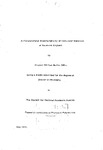A Foraminiferal Biostratigraphy of the Lower Senonian
| dc.contributor.author | Bailey, Haydon William | |
| dc.contributor.other | School of Geography, Earth and Environmental Sciences | en_US |
| dc.date.accessioned | 2011-09-26T13:10:48Z | |
| dc.date.available | 2011-09-26T13:10:48Z | |
| dc.date.issued | 1978 | |
| dc.identifier | Not available | en_US |
| dc.identifier.uri | http://hdl.handle.net/10026.1/689 | |
| dc.description | Merged with duplicate record 10026.1/1779 on 06.20.2017 by CS (TIS) | |
| dc.description.abstract |
The necessity for a micropalaeontological examination of the lower Senonian chalk of southern England was established during the site investigation of the Thames Barrier, which Is founded on chalk of the Micraster zones. There has been a large amount of detailed stratigraphic and micropalaeontological research carried out on the Late Cretaceous deposits of Europe, and this provides a historical framework onto which the present research is placed. Samples from three of the Thames Barrier boreholes were studied initially to provide an Indication of the microfauna and it's stratigraphic setting. This was followed by the collection and examination of a further seven sections from the Micraster zones of Rowe (1900-1 ~08). The localities selected give a geographical coverage of most of southern England. Single samples from three other localities have also been included. The microfauna observed shows a trend of Increasing diversity from the base of the Coniacian through into the Santonian. One hundred and twenty seven taxa have been described, the majority for the first time from the Engl ish succession, and this includes twenty taxa which have no previous recorded descriptions. The trend of increasing faunal diversity noted, makes the establishment of a zonation possible, based on the appearances and extinctions of twenty-five benthonic foraminiferal taxa. This zonation, when applied to all the sections studied, allows a correlation across the whole of southern England. • XVI .. XVII Lower Senonian foraminiferal faunas reported from the rest of Europe have been compared with those recorded in this country. Not only does this present a large amount of stratigraphic data, but It also gives an indication of the palaeogeographic setting of the region during the Late Cretaceous. | en_US |
| dc.language.iso | en | en_US |
| dc.publisher | University of Plymouth | en_US |
| dc.title | A Foraminiferal Biostratigraphy of the Lower Senonian | en_US |
| dc.type | Thesis | |
| dc.identifier.doi | http://dx.doi.org/10.24382/1580 | |
| dc.identifier.doi | http://dx.doi.org/10.24382/1580 |
Files in this item
This item appears in the following Collection(s)
-
01 Research Theses Main Collection
Research Theses Main


